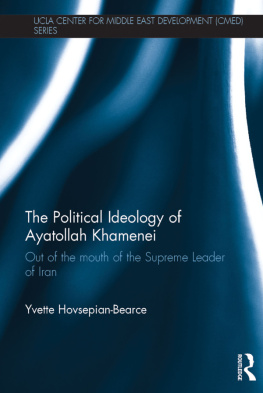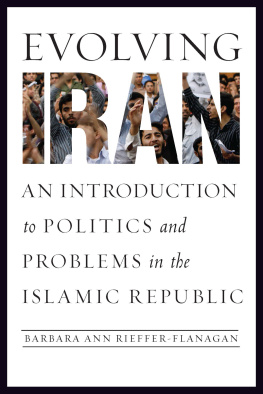THE STRUGGLE FOR DEVELOPMENT IN IRAN
The Evolution of Governance, Economy, and Society
Pooya Azadi, Mohsen B. Mesgaran, and Matin Mirramezani
STANFORD UNIVERSITY PRESS
Stanford, California
STANFORD UNIVERSITY PRESS
Stanford, California
2022 by Pooya Azadi, Mohsen B. Mesgaran, and Matin Mirramezani.
All rights reserved.
No part of this book may be reproduced or transmitted in any form or by any means, electronic or mechanical, including photocopying and recording, or in any information storage or retrieval system without the prior written permission of Stanford University Press.
Printed in the United States of America on acid-free, archival-quality paper
Library of Congress Cataloging-in-Publication Data
Names: Azadi, Pooya, author. | Mesgaran, Mohsen B., author. | Mirramezani, Matin, author.
Title: The struggle for development in Iran: the evolution of governance, economy, and society / Pooya Azadi, Mohsen B. Mesgaran, and Matin Mirramezani.
Description: Stanford, California: Stanford University Press, 2022. | Includes index.
Identifiers: LCCN 2021048614 (print) | LCCN 2021048615 (ebook) | ISBN 9781503630468 (cloth) | ISBN 9781503631540 (ebook)
Subjects: LCSH: Economic developmentIran. | IranEconomic conditions19451979. | IranEconomic conditions19791997. | IranEconomic conditions1997 | IranEconomic policy.
Classification: LCC HC475 .A934 2022 (print) | LCC HC475 (ebook) | DDC 338.955dc23/eng/20211029
LC record available at https://lccn.loc.gov/2021048614
LC ebook record available at https://lccn.loc.gov/2021048615
Cover photo: Tehran, Walter Bibikow, Getty Images
Typeset by Newgen in Minion Pro 11/14

CONTENTS
PREFACE
Writing about Iran and its complex history of development in the modern era is a difficult task. Much of the serious literature on modern Iran focuses on politics, political history, geopolitical affairs, or narrow economic or technical subjects. The intellectual discourse about the impediments of growth in Iran is dominated by an exaggerated notion of the role of ideology, class struggles, imperialism, and historical contingencies while overlooking the profound impacts of institutions and fundamental socioeconomic trends. In this environment, ironically, stating the truth based on undeniable facts and data is often deemed as a political act. Furthermore, there are issues with the availability and quality of data which render broad data-driven studies of Iran a tedious undertaking. The primary sources of data on Iran are sparse, nonhomogeneous, and often not available in a format that can be readily used. Secondary datasets, such as those compiled by international organizations, are limited in temporal coverage and scope, and in some cases, are inconsistent with the underlying primary source. These are the reasons, despite the great deal of attention that Iran receives from scholars and the media, there is still a lack of understanding of the fundamental forces and trends in its economy and society. Without deciphering Irans current issues by looking at the facts and data, predicting how the future of the country will unfold, both in domestic and international contexts, will remain guesswork. To address this issue, the Hamid and Christina Moghadam Program in Iranian Studies at Stanford University launched an initiative, the Stanford Iran 2040 Project, in 2016 to conduct data-driven research on key strategic areas relating to long-term development in Iran. The project has also been supported by the Freeman Spogli Institute at Stanford from the early stages of planning and development. The content of this book is based on the research conducted under this initiative.
In this book, we offer a multidimensional analysis of Irans struggle for development over half a century between 1970 and 2020. Iran in this period witnessed one king, two supreme leaders, over a dozen prime ministers and presidents, a revolution, a long war, numerous episodes of economic crises, international sanctions, and political turmoil, as well as profound social changes toward more modern ways of life. The book consists of a short introduction, nine chapters on different subjects pertinent to development, and a final reflection of what the future may entail for Iran. We hope we have constructed a fair and somewhat holistic picture of some of the complex issues of development in Irans modern history. The text has been written in clear and concise language which makes it accessible to a broad readership. The audience of the book encompasses researchers of a variety of disciplines, policymakers, journalists, and the business community. It can also be used as a textbook for a wide range of topics including Iranian studies, Middle Eastern studies, international development, political economy, and comparative politics.
Much of the content of this book is positive economics and data-driven analysis with a focus on fundamentals, institutions, and long-term trends. However, we have not been reluctant to criticize policies and policymakers if evidence and data warrant it. This approach distinguishes the present study from that of some other diaspora scholars whose work on Iran is, sadly, driven by their ideologies which can be anywhere across the political spectrum. For example, there has emerged a group of Islamic Republic apologists among the Iranian diaspora scholars with powerful roots in every domain of Iranian studies who are willing to openly or discreetly defend the regime under any circumstances using transparently fraudulent data and purposefully misleading arguments. On the opposite end, there are scholars who glorify the Pahlavi era with no regard for its shortcomings and the widespread dissatisfaction across large segments of Iranian society which ultimately led to the overthrow of the Shah and ended Irans dynastic era. We strived to produce an unbiased account of the developments in Irans troubled history of the past half century by drawing on evidence and citing data for every argument made throughout the book.
We welcome comments from scholars and experts and hope that this book contributes to professional and honest discourse among those who genuinely care about Iran and its future.
Pooya Azadi
California
June 2021
ACKNOWLEDGMENTS
Over the past five years, many colleagues and friends helped with the research presented in this book. We are greatly indebted to Abbas Milani, the director of the Hamid and Christina Moghadam Program in Iranian Studies at Stanford, not only for making the Iran 2040 initiative possible but also for generously sharing his vision and providing unconditional support. We are also thankful to Hamid Moghadam for his insightful and constructive comments on our research throughout these years. Our appreciation is also extended to Roma Parhad and Franco Errico for their invaluable help with every aspect of the Stanford Iran 2040 Project. We are grateful to Farzaneh Roudi, Razieh Zahedi, Sadra Sadeh, and Amin Feizpour who contributed to earlier versions of the work presented in . We would also like to thank Francis Fukuyama, Michael McFaul, and Behdad Aminzadeh for helpful comments and discussions on some of the working papers published by the Stanford Iran 2040 Project. We are grateful to the editorial and production teams at Stanford University Press, especially to Steve Catalano for his editorial guidance, encouragement, and thoughtful comments. Finally, we would like to thank our families for their support throughout the writing of this book.








